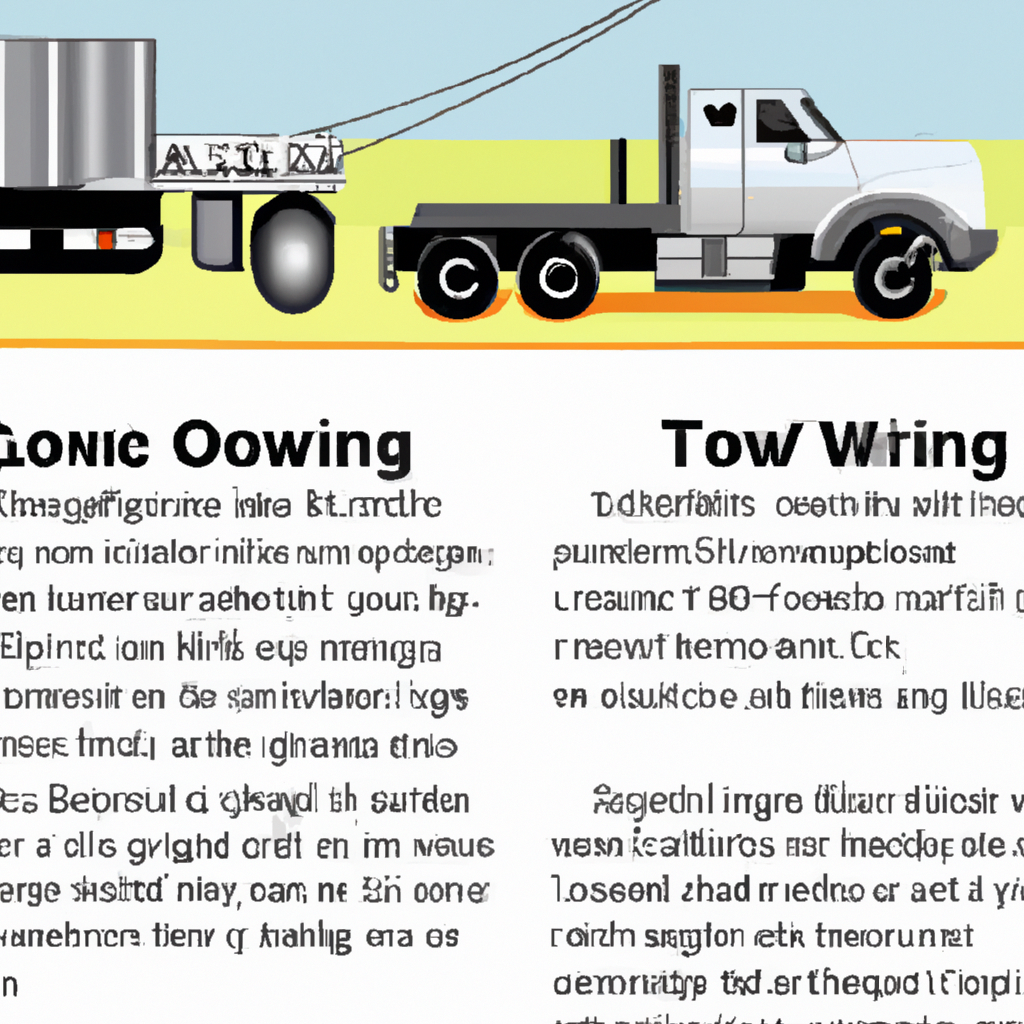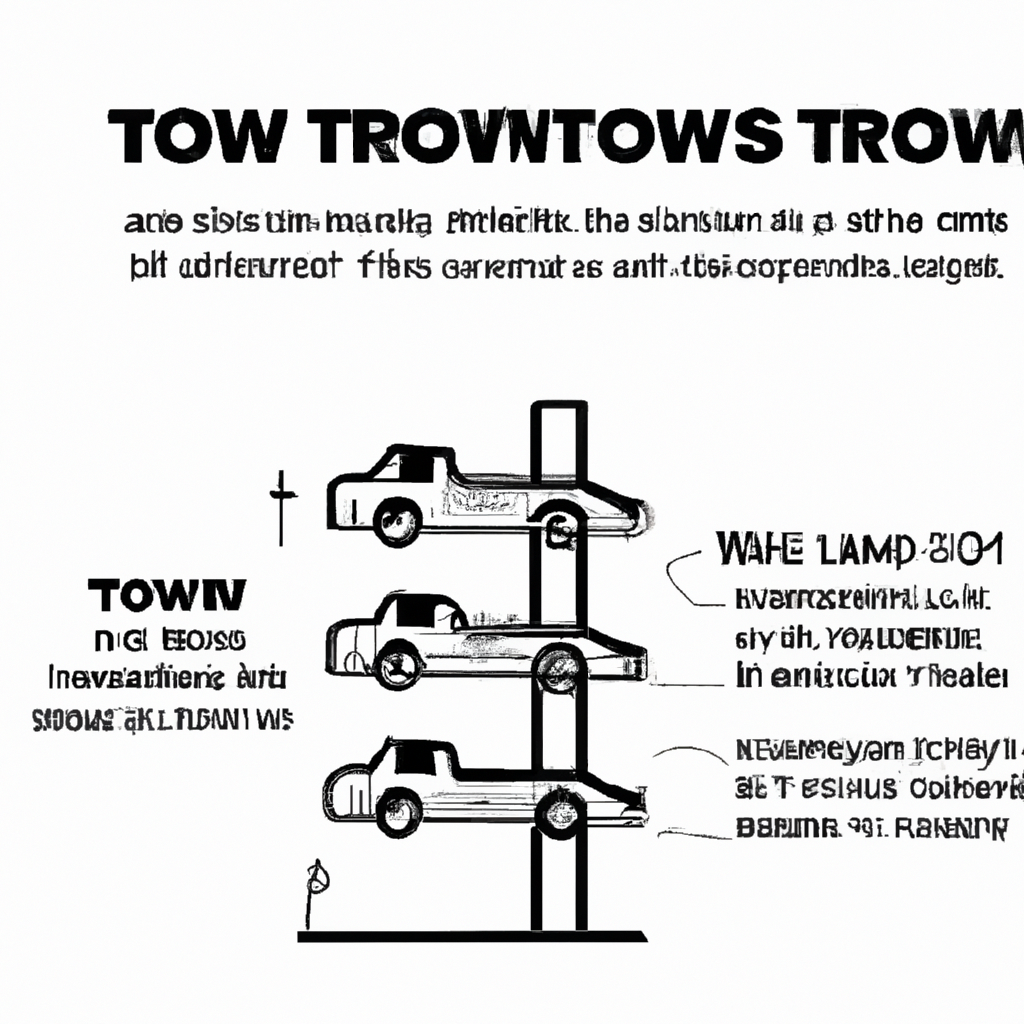In the realm of towing vehicles, speed is a crucial factor. When faced with the task of towing a truck, the question of how fast one can actually do it arises. The ability to tow a truck swiftly and efficiently is not only a matter of skill, but also paramount for minimizing any potential risks or delays. In this article, we will explore the factors that come into play when determining the speed at which a truck can be towed, along with key considerations that can help you achieve seamless and timely towing operations. So, if you’ve ever wondered just how fast you can tow a truck, read on to satisfy your curiosity and gain valuable insights into this intriguing aspect of towing prowess.

Factors Affecting Tow Speed
Vehicle Weight
One of the primary factors affecting tow speed is the weight of the vehicle being towed. The heavier the vehicle, the more force is required to tow it, which can impact the speed at which the towing vehicle can safely travel. It is essential to consider the weight distribution within the towing vehicle and ensure that it is equipped to handle the load.
Towing Capacity
The towing capacity of a vehicle refers to the maximum weight it can safely tow. Exceeding the towing capacity can lead to mechanical strain and increased safety risks. When determining the tow speed, it is crucial to consider the towing capacity of the vehicle and ensure that the load falls within the manufacturer’s specifications.
Braking System
The braking system plays a vital role in ensuring safe towing. When towing, the braking system needs to be capable of handling the additional weight and stopping distance required. It is important to have a braking system that can effectively control the vehicle and the load being towed, even at higher speeds.
Road Conditions
The condition of the road can significantly impact the tow speed. Uneven or slippery surfaces can reduce traction, making it more difficult to control the towing vehicle. It is important to take into account the road conditions and adjust the tow speed accordingly to ensure safe and stable towing.
Speed Limit
Adhering to the posted speed limit is not only crucial for the safety of all road users but also plays a significant role in towing. It is important to understand and follow the speed limits set by local authorities, as exceeding these limits can increase the risk of accidents or damage to the towing vehicle and the load.
Weather Conditions
Weather conditions, such as rain, snow, or strong winds, can have a considerable impact on the tow speed. Poor weather conditions can affect visibility and increase the risk of losing control of the towing vehicle. Adjusting the tow speed according to the weather conditions is essential to ensure safe and effective towing.
Driver Skill and Experience
The skill and experience of the driver also play a crucial role in tow speed. Towing requires specific driving techniques and knowledge to maintain control and ensure safety. A skilled and experienced driver will have a better understanding of how to handle various towing situations and adjust the speed accordingly.
Legal Considerations
Local and State Laws
When towing a vehicle, it is essential to be aware of and comply with the local and state laws regarding towing. Different jurisdictions may have specific requirements and restrictions regarding towing speed, equipment, and licensing. Familiarizing yourself with these laws will help ensure legal and safe towing practices.
Speed Restrictions
In addition to general speed limits, some areas may have specific speed restrictions for towing vehicles. These restrictions are typically in place to ensure the safety of both the towing vehicle and other road users. It is important to be aware of and adhere to any speed restrictions applicable to towing in your area.
Towing Regulations
Towing regulations encompass a range of requirements, including equipment specifications, weight limits, and licensing. These regulations are designed to ensure the safe and efficient operation of towing vehicles. Familiarize yourself with the towing regulations relevant to your location to avoid legal issues and maintain safety.
Special Permits
In certain cases, special permits may be required when towing oversized or overweight loads. These permits are necessary to ensure that the load can be transported safely and without causing damage to infrastructure or other road users. It is important to research and obtain any necessary permits before embarking on a towing journey to remain in compliance with the law.
Other Legal Requirements
Depending on the jurisdiction, there may be additional legal requirements for towing, such as proper lighting and signage. These requirements are in place to increase the visibility of the towing vehicle and load and to alert other road users to the presence of a towing operation. Understanding and meeting these requirements is essential to ensure both legal compliance and safety.
Towing Methods
Conventional Towing
Conventional towing, also known as hook and chain towing, involves attaching a towing vehicle to the disabled vehicle using a hook and chain. This method is often used for heavier vehicles that cannot be transported by other means. However, it is important to note that conventional towing may not be suitable for all vehicle types and can cause damage if not executed properly.
Flatbed Towing
Flatbed towing involves loading the disabled vehicle onto a flatbed truck or trailer. The vehicle is secured onto the flatbed, eliminating the risk of damage to the wheels or drivetrain. Flatbed towing is a popular method for transporting luxury or classic cars, as it provides a secure and damage-free transport solution.
Dolly Towing
Dolly towing involves using a two-wheel trailer to tow the disabled vehicle. The front or rear wheels of the disabled vehicle are placed on the dolly, while the remaining wheels remain on the ground. Dolly towing is commonly used for front-wheel-drive vehicles or those with limited ground clearance.
Tow Bar Towing
Tow bar towing, also known as dinghy towing or flat towing, involves attaching the disabled vehicle to the towing vehicle using a rigid bar or tow bar. This method is commonly used for lightweight vehicles that can be safely towed with all four wheels on the ground. Tow bar towing requires specific equipment and may have limitations based on the towing capacity of the vehicle.

Towing Capacity of Different Vehicles
Cars and Sedans
Most cars and sedans have a towing capacity ranging from 1,000 to 3,500 pounds. It is important to consult the owner’s manual or contact the manufacturer to determine the specific towing capacity for a particular make and model. Factors such as engine power, transmission type, and structural strength will influence the towing capacity of cars and sedans.
SUVs and Trucks
SUVs and trucks generally have higher towing capacities compared to cars and sedans. The towing capacity of SUVs can range from 2,000 to 8,000 pounds, while trucks can handle even larger loads, ranging from 5,000 to 30,000 pounds or more. It is important to consider the specific make, model, and engine configuration when determining the towing capacity of SUVs and trucks.
Commercial Trucks
Commercial trucks, including semi-trucks, have significantly higher towing capacities compared to regular consumer vehicles. The towing capacity of commercial trucks varies widely depending on the specific configuration, ranging from 10,000 to over 100,000 pounds. Commercial truck operators must ensure that they are aware of the towing capacity and adhere to all legal requirements and safety standards.
RVs and Motorhomes
RVs and motorhomes are designed for towing and have a towing capacity that accommodates additional vehicles, such as cars or boats. The towing capacity of RVs and motorhomes can range from 2,000 to 10,000 pounds or more, depending on the size and type of the vehicle. It is important to consider the weight distribution and stability when towing additional vehicles behind an RV or motorhome.
Impacts of Speed on Towing
Tire Wear and Heat Build-Up
High speeds can cause increased tire wear and heat build-up when towing. The additional weight and friction generated by towing can put stress on the tires, leading to faster wear and potential blowouts. It is important to monitor tire pressure, ensure proper tire rotation, and maintain appropriate speeds to minimize tire wear and heat build-up during towing.
Decreased Vehicle Stability
Towing can affect the stability of the towing vehicle, especially at high speeds. The added weight of the load can lead to increased sway and reduced control. Higher speeds can exacerbate these stability issues, making it difficult to maintain control of the towing vehicle. It is crucial to drive at a safe and controlled speed to ensure overall vehicle stability while towing.
Increased Stopping Distance
Towing increases the overall weight and momentum of the vehicle, resulting in a longer stopping distance. Higher speeds further amplify this effect, requiring more time and distance to come to a complete stop. Failing to account for the increased stopping distance can lead to accidents and collisions. It is important to maintain a safe following distance and reduce speed well in advance when towing.
Effect on Other Road Users
High speeds while towing can impact other road users. When towing a vehicle, it is essential to drive in a manner that prioritizes the safety of both the towing vehicle and other vehicles nearby. Excessive speed can impede other drivers’ ability to maneuver safely, leading to potential accidents. It is important to be considerate of other road users and adjust the towing speed accordingly.
Manufacturer Guidelines
Vehicle Owner’s Manual
The vehicle owner’s manual is a valuable resource when it comes to towing. It provides specific information regarding towing capacity, recommended towing speeds, and any unique considerations or limitations related to towing. Consulting the owner’s manual is crucial to ensure that towing is done in accordance with the manufacturer’s guidelines.
Manufacturer Recommendations
Manufacturers often provide additional recommendations specifically related to towing. These recommendations may include guidelines for load distribution, equipment requirements, and recommended towing speeds. Following the manufacturer’s recommendations can help ensure the safe and effective towing of a vehicle.
Specific Towing Instructions
Certain vehicles may have specific towing instructions provided by the manufacturer. This could include instructions for attaching tow bars, using towing accessories, or specific procedures to follow during towing. It is important to familiarize yourself with these instructions before towing a vehicle to ensure proper execution and mitigate risk.
Common Towing Speed Limits
Maximum Towing Speeds
Maximum towing speed limits refer to the top speed at which a vehicle can safely be towed without compromising safety or causing damage. These limits are usually set by the vehicle manufacturer and can vary depending on the towing method, vehicle type, and road conditions. It is crucial to adhere to the maximum towing speed limits to ensure safe transportation and reduce the risk of accidents.
Recommended Towing Speeds
Recommended towing speeds are typically provided by the manufacturer and take into account factors such as vehicle stability and load distribution. These speeds serve as guidelines to help achieve safe and controlled towing. It is important to consider the recommended towing speeds and adjust accordingly based on the specific towing circumstances.
Slow Speed Zones
In certain areas, such as residential neighborhoods, construction zones, or areas with heavy traffic, slow speed zones may be in effect. These zones impose lower speed limits to ensure the safety of both pedestrians and motorists. When towing, it is essential to respect and adhere to any posted slow speed limits to maintain safety and avoid potential violations.
Safety Tips for Towing
Inspecting Equipment
Before embarking on a towing journey, it is crucial to thoroughly inspect all towing equipment. This includes checking the hitch, safety chains, lights, and tires to ensure they are in good working condition. Regular maintenance and proper equipment inspection minimize the risk of equipment failures and accidents during towing.
Securing the Load
Properly securing the load being towed is essential for safe transportation. All items should be securely fastened and distributed evenly to maintain stability and prevent shifting. It is important to use appropriate tie-downs and straps to secure the load in place, ensuring it does not become a hazard while in transit.
Maintaining Proper Speed
Maintaining a proper towing speed is vital to ensure stability and control. It is essential to drive at a speed that allows for safe maneuvering and stopping, considering factors such as road conditions, traffic, and load weight. Adjusting speed based on these factors will help maintain a safe towing environment.
Keeping a Safe Distance
Maintaining a safe following distance is crucial when towing. The additional weight and stopping distance required means that more space is needed to react to unexpected situations. It is important to keep a safe distance from the vehicle in front to minimize the risk of collisions and allow for adequate braking time.
Using Turn Signals and Mirrors
Proper use of turn signals and mirrors is essential for safe towing. Signaling turns and lane changes well in advance allows other road users to anticipate and react accordingly. Additionally, using mirrors to monitor the towing vehicle, the load, and surrounding traffic helps maintain awareness and promotes safe towing practices.
Braking Techniques
Proper braking techniques are crucial when towing, as the additional weight affects stopping distance and vehicle control. Gradual braking is recommended to avoid sudden shifts in weight distribution, which can result in loss of control. It is also important to utilize trailer brake controllers or other braking aids, where applicable, to ensure balanced and controlled braking.
Relevant Technologies
Trailer Sway Control
Trailer sway control systems are designed to detect and mitigate trailer sway automatically. These systems use various sensors and mechanisms to apply the appropriate braking force and stabilize the trailer. By actively countering sway, trailer sway control systems enhance towing safety and minimize the risk of accidents.
Tow/Haul Mode
Tow/haul mode is a feature found in many vehicles equipped for towing. Activating tow/haul mode adjusts the vehicle’s transmission and engine settings, optimizing performance for towing conditions. This mode can provide benefits such as better power delivery, increased engine braking, and improved overall handling while towing.
Brake Assist Systems
Brake assist systems, also known as emergency brake assist, enhance braking performance during emergency situations. These systems detect emergency braking scenarios and provide additional brake force to help reduce stopping distances. Brake assist systems can be especially beneficial when towing heavy loads that require increased stopping power.
Electronic Stability Control
Electronic stability control (ESC) is a safety feature that helps prevent loss of control during towing. ESC constantly monitors the vehicle’s stability and senses when it is deviating from the driver’s intended path. In such cases, ESC applies individual brakes and adjusts engine power to stabilize the vehicle, reducing the risk of accidents or rollovers.
Anti-lock Braking System
Anti-lock braking systems (ABS) prevent the wheels from locking up during braking, allowing the driver to maintain steering control. ABS is especially important when towing, as the additional weight can cause wheel lock-up and loss of control. By pulsating the brakes in rapid succession, ABS helps the driver maintain stability and control during emergency stops.
Tire Pressure Monitoring System
Tire pressure monitoring systems (TPMS) help ensure proper tire inflation and reduce the risk of tire-related incidents during towing. These systems monitor the air pressure in each tire and provide real-time feedback to the driver. Maintaining proper tire pressure is essential for safe towing, as underinflated or overinflated tires can lead to reduced stability and increased tire wear.
Professional Towing Services
Benefits of Hiring Professionals
Hiring professional towing services offers numerous benefits, particularly when dealing with complex towing situations or oversized loads. Professional towing companies have the expertise, specialized equipment, and trained personnel to handle different towing scenarios safely and efficiently. By entrusting the towing to professionals, individuals can minimize risks and ensure the best possible outcome.
Speed Limitations Imposed by Companies
Professional towing companies often have specific speed limitations in place to ensure the safety of their operations. These limitations are typically based on factors such as load weight, equipment capabilities, and legal requirements. Customers hiring professional towing services should be aware of and adhere to these speed limitations to avoid jeopardizing safety and potentially voiding any liability coverage.
Insurance and Liability Coverage
Professional towing companies typically have insurance and liability coverage to protect themselves and their customers in the event of accidents or damage during towing. By hiring professionals, individuals can have the peace of mind that they are covered in case of any unforeseen incidents. However, it is essential to review the company’s insurance and liability policies to understand the level of coverage provided.
Service Availability
Professional towing services are available around the clock, ensuring assistance is just a phone call away in case of emergencies. This 24/7 availability means that individuals can rely on professional towing companies to provide timely and efficient service whenever it is needed. Whether it is a breakdown on the highway or an off-road recovery, professional towing services are ready to handle diverse towing situations.
